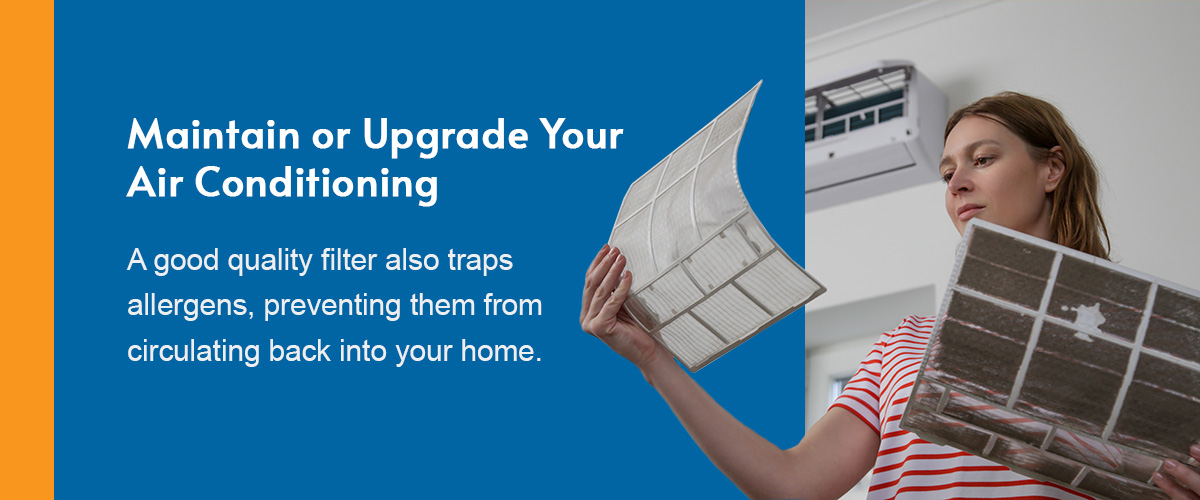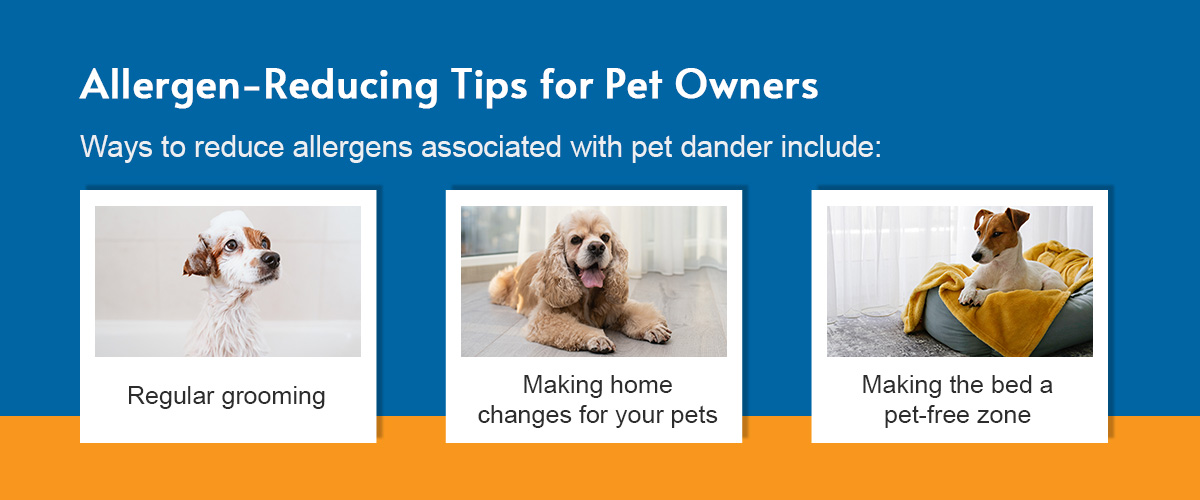
If you suffer from sneezing, sniffling and itchy eyes thanks to allergies, you are not alone. More than 100 million people in the U.S. suffer from allergies every year.
What form those allergies take can differ from person to person and can vary based on the type of substance you are allergic to. Although most commonly assume that many allergens come from the outdoors — such as tree, flower or grass pollen — there are just as many, if not more, allergens indoors. A few examples of indoor allergens include dust, mold and pet dander.
Fortunately, there are ways to reduce indoor allergens and allergy-proof your home. Discover how to reduce home allergens in the summer with these tips.
Table of Contents
- How to Decrease Allergens in Your Home in the Summer
- How to Remove Allergens From Your Home
- Allergen-Reducing Tips for the Bedroom
- Allergen-Reducing Tips for the Kitchen
- Allergen-Reducing Tips for the Living Room
- Allergen-Reducing Tips for the Bathroom
- Allergen-Reducing Tips for Pet Owners
- Remove Allergens With a UV Light or Indoor Air Purification System
- Get UV Lights and Indoor Air Purification Systems From SMO Energy
How to Decrease Allergens in Your Home in the Summer
Reducing allergens in your home becomes a lot easier when you understand your allergens and their triggers. While you may need to see an allergist to get precise answers, it is possible to find allergy hotspots in your home so you can work on improving those areas.
Tips for finding allergy hotspots in your house include:
- Keep a log of your symptoms: Jot down where and when your allergies seem to flare up and see if you can determine a pattern. For example, if you often wake up stuffy and sneezing, your bedroom is likely an allergy hotspot. Or if you notice your allergies occur more during certain months, you could have seasonal allergic rhinitis or hay fever.
- Determine the cause of your allergies: Once you know which room or rooms in your house are hotspots, you can try to pinpoint the cause of your allergies. Are there any moldy spots? Are there carpets in those rooms holding dust and pet dander? Could there be dust mites? A process of elimination and trying to clean up these areas to see if you notice improvements can be extremely helpful.
- Examine your symptoms: Examining your symptoms is vital for pinpointing what could be causing your allergies. As an example, if you are experiencing hives, there is a possibility it could be due to pollen, pet dander or mold. The chances increase if you have other symptoms like itchy, watery eyes and a runny nose. If you have hives alone, it’s more likely from exposure to fragrances or from foods or medications.
How to Remove Allergens From Your Home
Before diving into how to reduce indoor allergens in specific rooms of your home, consider how to reduce common indoor allergens from the whole house. These tips will help you keep allergens to a minimum throughout your home.
Maintain or Upgrade Your Air Conditioning
When you are looking at how to decrease allergens in your house in the summer, your air conditioning is the best place to start! Indoor air quality can have a significant impact on your allergies, so having an air conditioning system or maintaining or upgrading your HVAC systems is key to reducing allergens throughout the house.

The best place to start is with the air filter. The air conditioner’s filter helps keep dust and other debris from interfering with the equipment. A good quality filter also traps allergens, preventing them from circulating back into your home. But after a few weeks of continuous use in the late spring and summer, your air filter will most likely need cleaning or replacement.
Getting in the habit of regularly replacing your air conditioner’s filter will not only help to keep allergens out of your house, it can also help to extend the life of your air conditioner. We recommend changing your air filter every three months to ensure the air circulating through your system and into your home is as clean as possible.
Along with frequent filter replacements, it is important to schedule regular maintenance checkups to ensure your system runs as efficiently as possible.
Keep the Temperature Under Control
Climate control plays an important role in minimizing allergens in your home. When searching for the perfect temperature for your home, remember two things: cool and dry. After all, heat and humidity create an environment in which mold, mildew and other problematic substances grow.
Some allergens, such as mold and dust mites, thrive in warmer temperatures, especially if high humidity accompanies the warmth. Try to keep your home between 68 and 72 degrees Fahrenheit in the summer. Ideally, the humidity should not creep higher than 50 percent inside.
A tool known as a hygrometer can measure the humidity in each room of your home. If there are areas where the humidity is above 50 percent, you might want to invest in a portable dehumidifier to help dry out the space. You may also want to run your air conditioner to keep the home from getting too warm.
Shut the Windows to Keep the Pollen Out
Although you might love to throw open the windows on a warm spring or summer’s day, open windows and doors can let pollen into your home, worsening your allergy symptoms. To protect yourself and your loved ones, the best thing to do is to keep the windows shut. Rather switch on the air conditioning to keep your home cool and comfortable when it’s warm.
Deep Clean Your Home
Keeping your home clean can help to reduce the number of indoor allergens. But some cleaning methods are better than others:
- Use a damp cloth to clean dust so that you can trap it in the cloth. A dry cloth will only move the dust around.
- Keep surfaces free from clutter so there are fewer places for dust to collect.
- Use a vacuum with a high-efficiency particulate air filter, commonly known as a HEPA filter. HEPA filters can trap tiny particles, keeping them from swirling through the air as you clean.
- Use gentle, fragrance-free cleaning products, as certain harsh chemicals and fragrances can trigger allergies.
Change Your Clothing
To avoid bringing pollen indoors after you have been out and about, get in the habit of changing your clothes once you get back home. Another option is to have a long coat that you only wear outside and to store the jacket in an out-of-the-way area, such as a mudroom. Showering after returning home can also help to reduce the number of allergens you bring in.
Create a Shoe-Free Home
Similar to changing from outdoor clothing to indoor clothing when you get home, it might be worthwhile to make your house a “shoe-free zone.” Set up a small shelf by the entryways of your home and ask family members and friends to remove their shoes when they arrive.
Replace Carpet With Hard Floors
Carpeting, whether wall-to-wall or a few throw rugs, can be a nightmare for people with allergies. Allergens tend to settle into carpets and can be difficult to remove, even if you vacuum often. Every time you walk over the rug, the allergens get stirred up and can float back into the air.
If possible, trade your carpets for hard floorings, such as hardwood, laminate or tile. You will still want to vacuum and wet mop those areas regularly to keep allergens to a minimum.
If you cannot get rid of the carpeting throughout your house, the best place to start is in the bedroom. Replace the rugs or carpet with laminate or hardwood so that you are not sleeping in a room full of allergens.
De-Clutter Your Space
Do you collect items from your travels? Perhaps you have a few photo frames on ledges and mantles. While these knick-knacks can add a personal element to your home, they also gather extra dust. Try to remove all unnecessary decorations from spaces you frequently use. This will cut back on allergens. If you would prefer to keep your treasures out and in sight, remember to dust thoroughly on a regular basis to prevent buildup.
Allergen-Reducing Tips for the Bedroom
Now that we have looked at things you can do to reduce allergens throughout the house, we will take things room by room, starting with the bedroom. Here is what you can do to keep allergens out of the bedroom so that you can enjoy a healthy night’s sleep:
- Cover the mattress and pillows with zippered protectors: Covering your mattresses and pillows with zippered protectors will create a barrier between you and any dust mites that might be living on the mattresses or pillows. Wash the covers every three weeks. You can also try putting a piece of tape over the zippers to create an even tighter seal around the covers.
- Choose hypoallergenic pillows: If you’re allergic to down or feathers, choose pillows filled with a hypoallergenic, synthetic filling. Wash your pillows often and replace them every three years.
- Wash your bedding with hot water: Wash your sheets and other bed linens with hot water weekly. It is also a good idea to dry your bedding in a dryer rather than hanging it outside.
- Freeze stuffed animals: If you have kids who love to cuddle up with a favorite stuffed animal at night, freezing those stuffed animals for about 24 hours every few weeks will help kill off dust mites and reduce allergen exposure.
Allergen-Reducing Tips for the Kitchen
Along with dust and mold, the kitchen can be a prime spot for allergens such as cockroaches and other pests. Cockroaches are one of the leading causes of year-round allergies. To keep the critters out of your kitchen and to reduce other allergens in the room, here is what you can do:
- Keep surfaces dry: Cockroaches love water and will go anywhere there is something to drink. Wipe down countertops, stovetops, and sinks to remove any spills and traces of water. Keeping things dry will also help to keep mold away.
- Wash dishes and put them away daily: Load up your dishwasher and run it each night, or handwash any dishes in the sink, then dry them and put them away. You do not want roaches, mice or other pests to have anything to snack on.
- Check for leaks under sinks: A leaky kitchen sink can create an ideal environment for mold growth. Look under the sink for any issues and try to fix them as quickly as possible. It is also good to check under the sink for signs of pests, such as mouse droppings or roach webs.
- Upgrade your trash can: A trash can with a lid can help keep pests from finding their way into your kitchen If you have the option, try to use a trash can with a lid that seals to keep ants, mice and roaches out.
- Use methods to deter or eliminate cockroaches: If you do have a bug problem, use products such as roach bait to eliminate them. Depending on how pervasive the issue is, you might want to call in an exterminator.
- Install a hood fan that vents outdoors: A fan over the stove will help lower the humidity levels in your kitchen, reducing the risk of mold growth and food odors. Just make sure the fan vents to the outdoors, not back into the kitchen.
Allergen-Reducing Tips for the Living Room
Many of the previous tips for reducing allergens also explicitly apply to the living room. Beyond that, here are a few ways to keep allergens in your living space to a minimum:
- Choose your curtains carefully: If you like the look of curtains, choosing a pair you can wash easily is a good idea. Otherwise, the curtains can be a home for common indoor allergens, including dust mites and dust. Other options to consider instead of curtains include washable roller shades or even leaving the windows uncovered.
- Reconsider upholstery: Upholstered furniture can trap allergens and is difficult to clean. If possible, choose sofas and chairs made of leather or vinyl.
- Watch how much you water plants: By watering your houseplants appropriately, you avoid drowning the plant and reduce the soil’s mold risk. Usually, it is best to let the soil dry out completely on the top before you water again.
Allergen-Reducing Tips for the Bathroom
When it comes to allergy-proofing your bathroom, the best thing you can do is keep moisture and humidity levels under control. Bathrooms tend to be welcoming spaces for molds. Here is what you can do to prevent mold growth:
- Improve ventilation: Opening a window and running an exhaust fan while you shower will help to keep humidity levels in the bathroom under control. Keep the window open and the fan running even after you have finished showering.
- Run a dehumidifier: When it is humid outdoors, it can seem that no matter how much you ventilate the bathroom, humidity remains high. A room-sized dehumidifier can be a good investment.
- Limit your shower time: Running the shower for extended periods of time can give mold more opportunity to grow. Try to shorten your shower time to under 10 minutes. You can even make it a game with your family to see who can take the shortest shower!
- Hang up a nylon shower curtain: A nylon shower curtain is better able to resist mold growth compared to a vinyl curtain. Plus, it will not off-gas unpleasant chemicals, and you can wash it easily.
- Clean away any existing mold: If you see mold in the shower, bathtub or anywhere else in your bathroom, clean it up to reduce the chance of it spreading.
- Dry the shower after each use: After you use the shower, give it a quick wipe with a towel to remove any remaining water.
Allergen-Reducing Tips for Pet Owners
When you are a pet lover, there is no compromise — you naturally want your furry family members in the house with you. It can be challenging to manage allergies associated with pet dander, but the good news is that it is possible to reduce triggers and symptoms. Ways to reduce allergens associated with pet dander include:

- Regular grooming: Regularly combing, brushing, and washing your pets is good for their well-being and can help with allergy symptoms by reducing the level of dander. Use a pet-appropriate anti-dander shampoo for extra impact.
- Making home changes for your pets: If you have pets, you can reduce dander by having hardwood floors in place of carpets and by having couch-covers that you can regularly throw in the wash.
- Making the bed a pet-free zone: It really is a tough one, but keeping your pets out of your bedroom, or at the very least, off your bed, can greatly reduce your symptoms. This way, you won’t breathe in pet dander all night while sleeping.
Remove Allergens With a UV Light or Indoor Air Purification System
For those who are looking to eliminate allergens throughout an entire home, a UV light or indoor air purification system may be a great solution. You can install ultraviolet (UV) lights in your HVAC system to kill mold, bacteria and other allergens before they enter the air. Additionally, UV lights will prevent mold from growing on your system’s coils, ensuring that your HVAC system lasts even longer!
Indoor air purification systems and air filters trap small particles from the air, including dirt, mold, dust mites, bacteria and viruses. Depending on your needs, UV lights may be added to an existing HVAC system, or additional free-standing air purification units can be purchased to filter the air in a single room.
According to the Environmental Protection Agency (EPA), the average American spends as much as 90 percent of their time indoors and the concentration of pollutants is estimated to be up to 2 to 5 times higher than the average outdoor pollutant concentration, making it all the more important to improve the air quality in your home.
Get UV Lights and Indoor Air Purification Systems From SMO Energy
Here at SMO Energy, we offer a selection of UV light and indoor air purification systems to keep your home free of allergens year-round. As you gear up for allergy season and the warm summer months, do not forget to schedule your air conditioning or HVAC system tune-up. Keeping your system up-to-date and well-maintained will help you and your family breathe easier all summer.
With over 95 years of experience and certified technicians for all HVAC services, SMO Energy is your local air conditioner expert in Southern Maryland. In the heat of summer, we understand how important it is to keep your home cool, energy-efficient and allergen-free. We offer free energy consultations and estimates as well as special financing options for air conditioner replacements and installations. Call us at 1-888-222-3720 today to speak directly with a member of our team.
